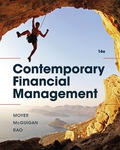
EBK CONTEMPORARY FINANCIAL MANAGEMENT
14th Edition
ISBN: 9781337514835
Author: MOYER
Publisher: CENGAGE LEARNING - CONSIGNMENT
expand_more
expand_more
format_list_bulleted
Concept explainers
Question
Chapter 3, Problem 7P
Summary Introduction
To discuss: Effect of reducing average collection period on Company S’s
Expert Solution & Answer
Trending nowThis is a popular solution!

Students have asked these similar questions
16. ____ underwriting commitment is when the underwriter agrees to buy the entire issue and assume full financial responsibility for any unsold shares.*
Best efforts
Firm commitment
All-or-none
Full-purchase
Which of the following is not true about private equity funds?*
Private equity funds are pools of capital invested in companies which represent an opportunity for high rate of return
Exit strategies for private equity funds include Initial Public Offerings (IPOs) and leveraged buyout (LBO)
Venture capital is an example of private equity funds
Private equity funds are usually invested for unlimited time periods
What is finance ?
explain about its parts.
Chapter 3 Solutions
EBK CONTEMPORARY FINANCIAL MANAGEMENT
Ch. 3 - Prob. 1QTDCh. 3 - Prob. 2QTDCh. 3 - Prob. 3QTDCh. 3 - Prob. 4QTDCh. 3 - Prob. 5QTDCh. 3 - Prob. 6QTDCh. 3 - Prob. 7QTDCh. 3 - Prob. 8QTDCh. 3 - Prob. 9QTDCh. 3 - Prob. 10QTD
Ch. 3 - Prob. 11QTDCh. 3 - Prob. 12QTDCh. 3 - Prob. 13QTDCh. 3 - Prob. 14QTDCh. 3 - Prob. 1PCh. 3 - Prob. 2PCh. 3 - Prob. 3PCh. 3 - Prob. 4PCh. 3 - Prob. 5PCh. 3 - Prob. 6PCh. 3 - Prob. 7PCh. 3 - Prob. 8PCh. 3 - Prob. 9PCh. 3 - Prob. 10PCh. 3 - Prob. 11PCh. 3 - Prob. 12PCh. 3 - Prob. 13PCh. 3 - Prob. 14PCh. 3 - Prob. 15PCh. 3 - Prob. 16PCh. 3 - Prob. 17PCh. 3 - Prob. 18PCh. 3 - Prob. 19PCh. 3 - Prob. 20PCh. 3 - Prob. 21P
Knowledge Booster
Learn more about
Need a deep-dive on the concept behind this application? Look no further. Learn more about this topic, finance and related others by exploring similar questions and additional content below.Similar questions
arrow_back_ios
SEE MORE QUESTIONS
arrow_forward_ios
Recommended textbooks for you
 EBK CONTEMPORARY FINANCIAL MANAGEMENTFinanceISBN:9781337514835Author:MOYERPublisher:CENGAGE LEARNING - CONSIGNMENT
EBK CONTEMPORARY FINANCIAL MANAGEMENTFinanceISBN:9781337514835Author:MOYERPublisher:CENGAGE LEARNING - CONSIGNMENT Intermediate Financial Management (MindTap Course...FinanceISBN:9781337395083Author:Eugene F. Brigham, Phillip R. DavesPublisher:Cengage Learning
Intermediate Financial Management (MindTap Course...FinanceISBN:9781337395083Author:Eugene F. Brigham, Phillip R. DavesPublisher:Cengage Learning

EBK CONTEMPORARY FINANCIAL MANAGEMENT
Finance
ISBN:9781337514835
Author:MOYER
Publisher:CENGAGE LEARNING - CONSIGNMENT

Intermediate Financial Management (MindTap Course...
Finance
ISBN:9781337395083
Author:Eugene F. Brigham, Phillip R. Daves
Publisher:Cengage Learning
The management of receivables Introduction - ACCA Financial Management (FM); Author: OpenTuition;https://www.youtube.com/watch?v=tLmePnbC3ZQ;License: Standard YouTube License, CC-BY